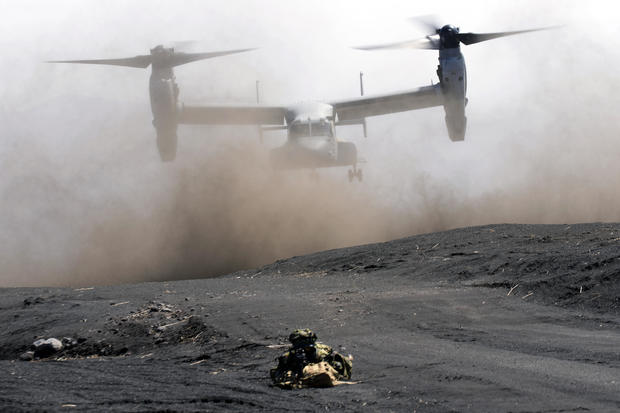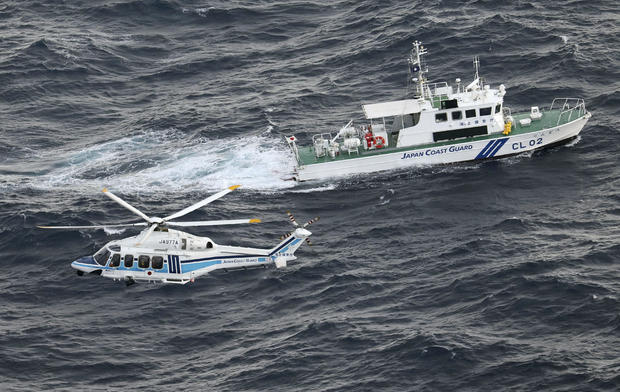Tokyo — The search for seven American service members continued Thursday in Japan’s waters after a U.S. Air Force Osprey aircraft crashed into the sea off the tiny island of Yakushima, killing at least one person, according to U.S. and Japanese officials. The Japan Coast Guard remained in charge of the search and rescue operation and had deployed side-scan sonar to scour the seabed for evidence of the ill-fated Osprey.
Japanese coast guard vessels and helicopters were being aided in the search by craft from the Japan Self-Defense Forces, the nation’s military. Several pieces of debris believed to be from the Osprey were recovered from the water Wednesday, in addition to a large, empty orange life raft.
A U.S. defense official confirmed to CBS News on Wednesday that one of the crew members had died, after an official with Japan’s coast guard said a body was recovered from the water. Seven people remained missing.

Kyodo via REUTERS
U.S. Air Force Special Operations Command said in a statement later Wednesday that the Osprey was performing a routine training mission when it crashed, but it did not confirm that one of the crew members had died, saying the that both the “cause of the mishap” and the “crew’s condition are unknown at this time.”
Ospreys’ history of crashes, and tension with Japan
Japan’s Minister of Defense said Thursday that the country, one of America’s closest allies in Asia, had asked the U.S. to stop flying Ospreys over Japan until the aircraft could be confirmed safe.
The fact that the U.S. military has 30 of Ospreys in service in Japan is evidence that it believes the planes are safe, but Japanese politicians needed to reassure a very nervous public.
Tuesday’s crash took place very close to shore, fueling fear among the Japanese people after a series of incidents with the aircraft that one day, an Osprey could plunge out of the sky onto their heads and kill innocent civilians.

Damon Coulter/SOPA Images/LightRocket/Getty
It’s a contentious issue, and part of the wider contentious topic of the huge U.S. military presence in Japan, where there are some 50,000 American personnel stationed.
- Japan approves new funding for U.S. military presence as threats loom large
While the bilateral defense alliance has remained solid, there’s been tension for many years, and Tuesday’s crash will fuel it — in part because, while Japan’s Coast Guard scrambled ships and helicopters as soon as local fishermen raised the alarm, the U.S. military will likely take over the recovery and the investigation into the crash and, for the most part, exclude the Japanese.
In a statement shared Thursday on social media, U.S. Ambassador to Japan Rahm Emanuel expressed his “sincere gratitude to the Japanese Coast Guard, Japanese Self-Defense Forces, and local community and fishermen who are assisting in the search for the crew.”
“Our thoughts are with the servicemembers and their families. First and foremost, our focus is on the ongoing search and rescue operations, and we’re praying for a safe return,” Emanuel said, adding: “The strength of an alliance isn’t measured when times are good, but how we support each other in the face of adversity.”

Eugene Hoshiko/AP
Japan is the only country in the world apart from the U.S. to fly Ospreys. The Japan Self-Defense Forces has 11 of the U.S.-made aircraft already, and a few more on order.
The defense ministry said Thursday that it would temporarily ground its own fleet.
There have been a spate of fatal U.S. Osprey crashes in recent years, most recently an aircraft that went down during a multinational training exercise on an Australian island in August, killing three U.S. Marines and leaving eight others hospitalized. All five U.S. Marines on board another Osprey died the previous summer when their aircraft crashed in the California desert.
The U.S. military’s investigation found that “dual hard clutch engagement” leading to engine failure led to that crash. The U.S. Marine Corps and Navy have reported similar clutch slips in their Ospreys and said they have worked to address the issue, according to The Associated Press.
An Osprey crashed in shallow water just off the Japanese island of Okinawa in 2016, but all the U.S. Marines on board survived that incident.
Despite the crashes, the versatility of the Osprey — which can take off and land like a helicopter but then tilt its rotors to fly as a turbo-prop plane — has made it a trusty workhorse for the U.S. military, especially for troop transport.
Both the Japanese and U.S. militaries will likely want to be able to continue using them in the highly strategic corner of the western Pacific.
Japanese reporters said they had seen saw multiple U.S. Ospreys take off Thursday from Okinawa, where the U.S. has its biggest military base in the region, so there was no sign that the U.S. was acting on Japan’s request for a grounding of the aircraft.
Elizabeth Palmer 
Elizabeth Palmer has been a CBS News correspondent since August 2000. She has been based in London since late 2003, after having been based in Moscow (2000-03). Palmer reports primarily for the “CBS Evening News.”
